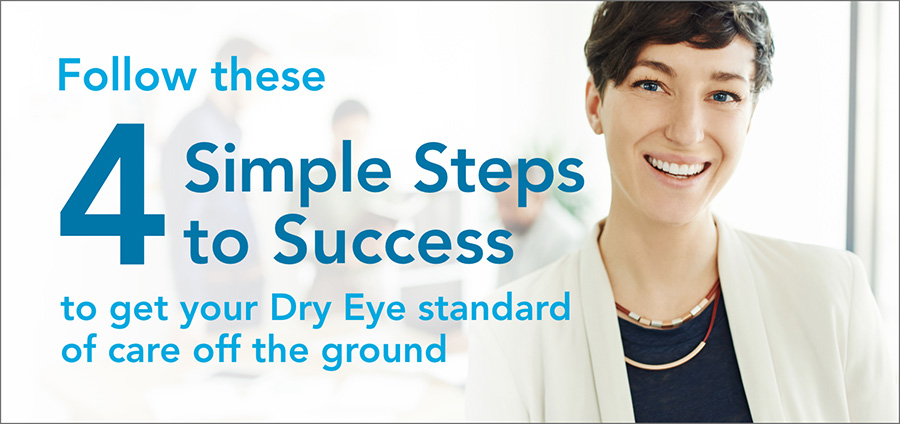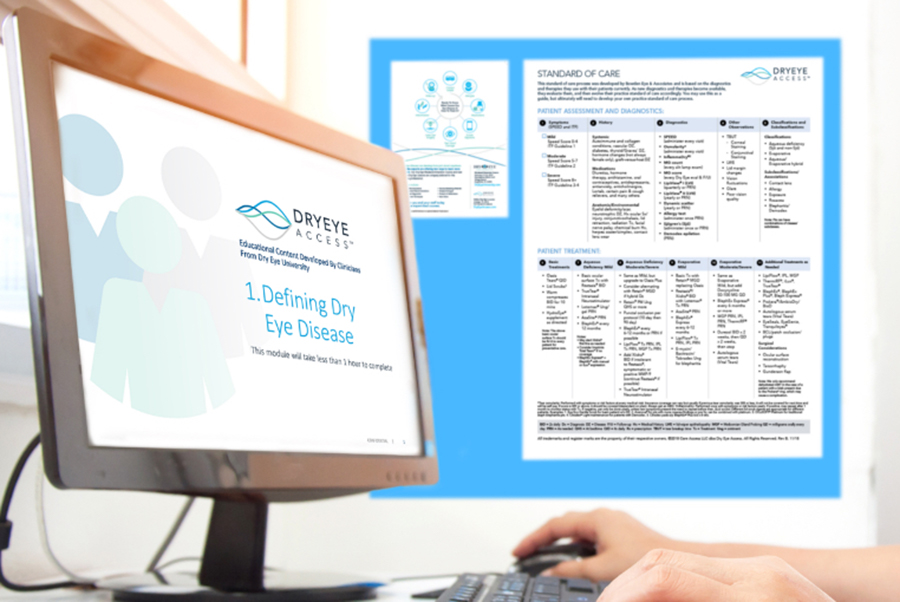Implementing Dry Eye Treatment Protocols: Where to Start

Now that your staff is trained, you feel like your practice is ready to introduce your patients to relief from Dry Eye Disease. How will you implement your new Standard of Care and make sure your entire staff is following your Dry Eye treatment protocols?
As your office “Dry Eye Champion,” you will lead the charge among staff members and help with the implementation of your new Dry Eye Treatment protocols.


Complete the Practice Implementation Course
The Practice Implementation course allows eye care professionals to get a sense of how to put Dry Eye treatment protocols and systems in place, including lessons on Planning Your Dry Eye Clinic, Facility Requirements, Reimbursement and Training. Once you’ve determined the type of Dry Eye care your practice will provide (Referral Care, Shared Care, or Comprehensive Care) you’ll be able to get started on Developing your Standard of Care.
Not a member of Dry Eye Access?
All courses and tools are open to members of DryEyeAccess.com. Not yet a member?


Prepare Patient Files with the SPEED* Questionnaire
Whether the patient is presenting with Dry Eye symptoms or not, all patients should be administered the SPEED Questionnaire at the beginning of every visit as part of your standard protocol. Members of Dry Eye Access can download the modified SPEED Questionnaire and read the supplementary page to fully understand how and why it works.
If you use paper files, print out the SPEED Questionnaire and make plenty of copies, and place one in every patient’s file who has an appointment scheduled. Or, if you use electronic records, make sure the PDF is readily available to open and complete for each electronic record. Whether paper or digital, using the SPEED Questionnaire consistently is key to keeping track of any noticeable changes in Dry Eye symptoms from appointment to appointment. Discuss with your staff who will be asking patients the SPEED questions. Make sure they thoroughly notate all answers, as it’s imperative that it’s not left to the patient to complete the SPEED Questionnaire by themselves.
*The SPEED Test originated through TearScience. After the addition of qualifying patient questions, we have modified our version into the SPEED Questionnaire.


Visualize Your Standard of Care
Members of Dry Eye Access can download Bowden Eye & Associate’s Standard of Care guide and use it to determine your own practice’s diagnostics and Dry Eye treatment protocols. This guide features types of patient assessments from history, diagnostics, classifications to subclassifications, and types of patient treatments.
While your practice is new to Dry Eye Disease, the Bowden Eye & Associates’ sample Standard of Care guide will help you while you develop your own.* Once you have established what your practice will offer, you can create your own Standard of Care. Then, you want to familiarize everyone in your office with your Dry Eye Standard of Care. There is a lot to remember, so it’s often helpful to quiz staff members on what your practice will be offering, depending upon the patient’s symptoms and severity of Dry Eye Disease. Unlike the SPEED Questionnaire, you don’t fill out the Standard of Care for each patient. But, you need to make sure it is readily available for visual reference by all staff members whether that is on paper or electronic.
Post your Standard of Care where staff members can be reminded of your new Dry Eye treatment protocols. Be emphatic about your staff learning these new protocols. Conduct a lunch and learn—or two (one for diagnostics and one for treatments, if necessary) so all staff members have a thorough understanding of exactly what the Dry Eye protocols of your practice are. This process starts all over for new staff members, so no one in your office is ever caught off guard not knowing how to properly answer a question about Dry Eye Disease.


Understand Exactly What Your Practice Needs—And Will Need
Is your practice Referral Care, Shared Care or Comprehensive Care? Members of Dry Eye Access can download our Implementation Checklist, which provides a suggested list of needs for each practice type. It provides a rundown on the types of Dry Eye systems your practice will want to invest in, what you absolutely need now, and what your practice will offer in the future.
Keep your staff apprised of new diagnostics and treatments you’ll be providing as part of your Dry Eye Disease protocols. Hold regular roundtable discussions with your staff as your systems and services grow. If at all possible, let your staff experience the Dry Eye Disease treatments for themselves. They’ll be better able to talk to patients about what to expect. The more you keep staff informed, the more invested in your practice they’ll become.

Not a Member?
Join Dry Eye Access today!
Just one membership gives
Dry Eye Disease online learning, practice resources, and implementation tools to
your whole staff.
The lessons, courses and tools mentioned here are provided by the experts at Bowden Eye & Associates and are featured in their comprehensive Dry Eye University events.
Become a Dry Eye Access Member Today!
As a member, you and your practice staff get online education, practice resources and implementation tools that will help you adhere to a uniform approach of diagnosing and treating Dry Eye Disease.

